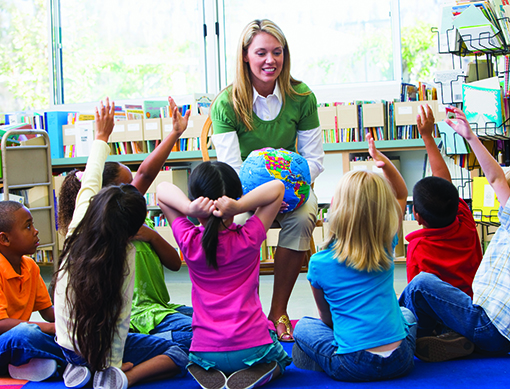Many years ago, while visiting a Catholic school Kindergarten program, I sat in on a lesson which the teacher was presenting to children seated in a circle on the floor. She was trying to get across the point of how we learn right from wrong and the people who help us learn those values. She was working up to the fact that God always teaches us things, even adults, and helps us make good choices because God loves us.
 The teacher talked about her boss, the school principal, and all the things the principal helped the teacher learn. She pointed out that everyone has a boss of some kind, even the Holy Father, the Pope.
The teacher talked about her boss, the school principal, and all the things the principal helped the teacher learn. She pointed out that everyone has a boss of some kind, even the Holy Father, the Pope.
“Do you know who the Pope’s boss is,” she queried, certain she would get the answer she was looking for.
A little boy waved his hand with gusto, barely able to keep his seat. “I know, I know,” he said. The teacher asked him for his answer. Without hesitation, the little boy replied, “His mom!”
The wisdom of children.
Certainly, for a time, parents are bosses, but they are always teachers, the most important teachers children can have. But there are other people in the life of a child who helps inform and form the child.
The role of the teacher is extraordinarily important in the lives of children. Eleanor Roosevelt thought it was so important that, in 1953, she petitioned Congress for a National Day of Recognition for teachers. The National Education Association (NEA) in partnership with the Kansas State and Indiana State Boards of Education, lobbied Congress so the day might be recognized. The first National Teacher Day didn’t become an official national day until 1980. Today it is celebrated on May 3.
How might National Teachers’ Day fit into the religious education classroom?
Talk about Jesus’ teachers. Scripture says that Jesus grew in wisdom, grace, and age before God and the people. When his parents found him in the temple in Jerusalem, he was among the teachers, listening to them and asking them questions (Luke 2:46-47). Religious education was part of the upbringing of the children (Colossians 3:15-17). Teaching Scripture, praying by singing psalms, and fostering a spirit of gratitude to God were important aspects. We see that Jesus, the consummate Teacher, had teachers of his own. Who might students see as Jesus’ teachers? Discuss the roles of Mary and Joseph, and the great teachers, Rabbis, of Jesus’ time.
Educate with love – and gratitude. Speaking with students, teachers, and parents, Pope Francis once said, “One cannot educate without love. You cannot teach words without gestures, and the first gesture is the caress: to caress hearts, caress souls. And what is the language of the caress? Persuasion. One teaches with the patience of persuasion. Witness, loving-kindness, caresses, persuasion.” Encourage your students to identify those people who have taught them with loving-kindness. Provide an opportunity for your students to express their gratitude to that person through a personal note, or for younger students, through art. While your students may wish to express their gratitude to you, encourage them to think of who else might be a teacher for them – school principal, coach, crossing guard. Or perhaps, Jesus, God, or a special saint?
Join your students. Create your own thank you to someone who has taught or mentored you. Let your students know that you are also expressing gratitude for a teacher's gift in your life. Your personal note may be an act of loving-kindness that makes a beautiful difference in someone’s day.
For a resource to help children learn about the life of Jesus through Scripture, consider the RCL Benziger grade-level series - Blest Are We Faith in Action - School Edition Grades K-8.
 About the Author
Mary Regina Morrell, mother of six and grandmother to nine, is a Catholic journalist, author, and syndicated columnist who has served the dioceses of Metuchen and Trenton, New Jersey, and RENEW International in the areas of catechesis and communication.
About the Author
Mary Regina Morrell, mother of six and grandmother to nine, is a Catholic journalist, author, and syndicated columnist who has served the dioceses of Metuchen and Trenton, New Jersey, and RENEW International in the areas of catechesis and communication.
